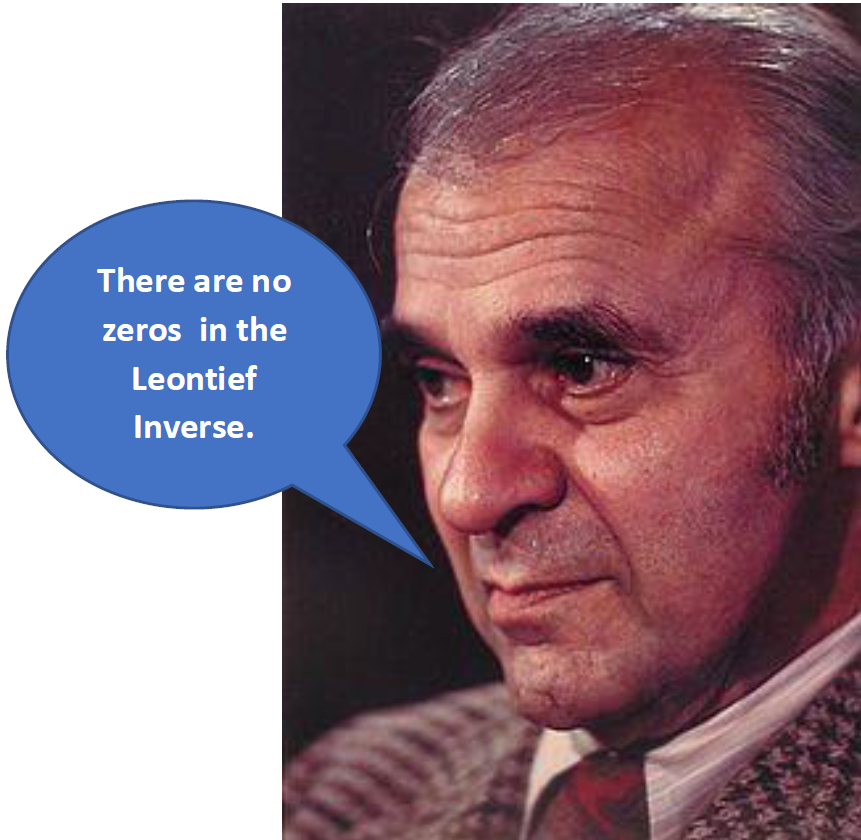A slightly extended version of part of my chapter “the Joy of Economics” from Surfing economics published in 2002.
Subtitle: There are no zero’s in the Leontief Inverse.
To an economist who understands things, everything is interconnected. Supply chains and production processes link and combine all goods and services. If you just look at the surface, you will see the things you buy: a meal, a laptop, pants. It is a particular product at a particular place at a point in time. However, when you look deeper, you see a whole world of linkages underneath. Unless you are a self-sufficient survivalist living in the wilderness of Montana, almost everything of economic value is linked to almost every other part of the global economy.
Take the classic example of a pencil. At its most basic, a pencil consists of wood, graphite and some paint. Of course, lots of other stuff is required to combine these ingredients to produce pencils (labour, capital, buildings, energy, transport). However, let us stick to the three “ingredients”. Let us go back to the wood. This required a forest, trees being chopped down and processed to produce the wood, again using machines and labour and buildings. That was the easy bit. What about the graphite? This can be produced synthetically by the Acheson process which is described by Wikipedia “In the furnace, the silicon dioxide, which sometimes also contains other additives, is melted surrounding a graphite rod, which serves as a core. An electric current is passed through the graphite, which heats the mixture to 1700–2500 °C.” Alternatively, graphite can be mined and is extracted from gangue rock by a lengthy process of beneficiation. The mines are found in a few countries, the main ones being China, India, Brazil and Turkey. Clearly a lot of stuff goes into producing the graphite. What of the paint? Again, this is a highly industrialised chemical process involving factories and using many ingredients. So, even a simple product like a pencil has taken us to Graphite mines in India, Forests in Canada and chemical factories producing paint. Sand that is just the first step. We can go to stage two and ask: what is used in the production of graphite, paint and wood? And then back again. It is, in effect an infinite regress. If we take any product or activity, there are always other goods and services involved in its production.
So, how can we make sense of all of this, apart from stand back in awe, and like Blake:
“To see a world in a grain of sand
And heaven in a wild flower.
To hold infinity in the palm of your hand
And eternity in one hour.”
William Blake…Auguries of Innocence.
Except in our case, we see infinity in a pencil. The economist who captured infinity was Wassily Leontief. He started from an input-output matrix. This just has the first stage of the infinite regress for each individual product. In the case of the pencil we simplified this as just three: graphite, wood and paint. So, suppose we have a hundred products: each product will have a row of 100 input-output coefficients, telling us which of the 100 products are used directly in the production of one unit of that product. The pencil will have row with 97 zeros, and the three relevant quantities used to produce one unit of pencils (per 1000 for example). The matrix is simply the stacked rows for each product giving the direct inputs for each product.
What Leontief did was ask the big question: if these are the direct inputs, what are the total inputs, both direct and indirect? Silicon dioxide is not used directly to produce a pencil, but it is used to produce the graphite that goes into the pencil. Each step back we regress looking at the inputs of inputs, more and more products are drawn into the production of final products and services. He solved this question with a brilliant answer which was just a simple bit of Matrix Algebra. First, he created a Matrix which had for each product a row in which there was a 1 for the product itself and subtracted the inputs using the input-output matrix. He took the inverse of this input-output matrix, to obtain the Leontief inverse which sums up the infinite regress to give you the total input of each product in producing the pencil, direct and indirect. In maths, the input-output matrix is A, and the Leontief Matrix is simply [I-A] inverse.
Now, it is a general property of this inverse Matrix that even if the original matrix has lots of zeros, the Leontief inverse will not have any zeros (except for some special cases). That is, everything is used to produce everything else, either directly or indirectly. Of course, we can see there are some types of product that are directly used in most if not all products: these are non-zeros in the input-output matrix. Such products include energy and transport and indeed labour of various types. However, there are lots of invisible links between products and services that are revealed by the Leontief inverse. And what this Leontief inverse matrix reveals is that all products and services are involved either directly and indirectly in producing every single product.

